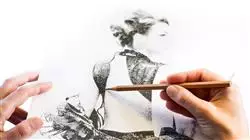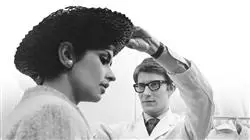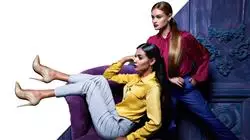University certificate
Scientific endorser

The world's largest faculty of design”
Introduction to the Program
You are just one step away from showcasing your collections in London, Paris or New York. Enroll in this program and develop the skills to make it happen”

Fashion Design has evolved by leaps and bounds in recent decades. Technological advances, access to more information and changes in consumer habits and lifestyles have all increased customer demand, who expect high-quality garments and accessories at affordable prices. But these requirements also include a commitment to innovation, the creation of trends and even the use of increasingly sustainable materials.
Furthermore, modern society has gone from a digitally-oriented environment to being fully focused on developing tools and alternative virtual realities from the perspective of sustainability and innovation. Augmented reality applications and 3D design systems are no longer a gaming-related option, but part of everyday life, becoming the future business model for the field. All of this means that fashion designers have transitioned from being garment creators to multidisciplinary professionals who must possess broad knowledge of the fashion industry in general and must be able to manage all the phases of the process.
This Professional master’s degree in Fashion Design is aimed at all those who want to develop in this discipline from an agile and current perspective, oriented toward adapting to change, both from the area of visual identity and the production of a collection, as well as in the use of new materials and technologies that are transforming the world. A program designed with the primary objective of promoting professional growth, guiding students toward excellence.
One of the main advantages of this program is that it is offered in a 100% online format, so students themselves plan their study, choosing the place and time that best suits them. That way, students can continue with their training while carrying out the rest of their daily obligations, whether work or personal.
If you want your collections to be as recognized as those of Giorgio Armani or Tom Ford, you just have to strive to improve your skills with this program”
This Professional master’s degree in Fashion Design contains the most complete and up-to-date academic program on the market. Its most notable features are:
- Practical cases presented by experts in fashion
- The graphic, schematic, and practical contents with which they are created, provide practical information on the disciplines that are essential for professional practice
- Practical exercises where the self-assessment process can be carried out to improve learning
- Special emphasis on innovative methodologies in fashion design
- Theoretical lessons, questions to the expert, debate forums on controversial topics, and individual reflection assignments
- Content that is accessible from any fixed or portable device with an Internet connection
TECH gives you the opportunity to acquire a higher level of specialization in Fashion Design through a 100% online methodology, which is essential to balance your studies with the rest of your obligations”
Its teaching staff includes professionals from the fashion industry, who bring to this program the experience of their work, as well as renowned specialists from leading societies and prestigious universities.
The multimedia content, developed with the latest educational technology, will provide the professional with situated and contextual learning, i.e., a simulated environment that will provide an immersive training experience designed to train for real-life situations.
This program is designed around Problem Based Learning, whereby the student must try to solve the different professional practice situations that arise during the academic year. For this purpose, the student will be assisted by an innovative interactive video system created by renowned and experienced experts.
Fashion is constantly evolving, so your designs must keep up with changes in society and lifestyles"

Have you always dreamed of designing the costumes for major Hollywood movies? Thanks to this program, you will be one step closer to achieving it"
Syllabus
This Professional master’s degree in Fashion Design has been structured considering the academic needs of professionals in the field, who seek to improve their skills while they continue fulfilling their work obligations. A 100% online format therefore offers them the opportunity to learn about different topics, such as textile products, accessories and jewelry, special garments, fashion trends or the most current digital tools used in the industry.

Create sustainable garments and accessories, and commit to a fashion industry that protects the environment”
Module 1. Structural and Integral Fashion Design
1.1. Expressive Drawing
1.1.1. Anatomical Structure of the Human Body
1.1.2. Three-Dimensional Space
1.1.3. Perspective and Matrix Analysis
1.2. Visual Semiotics
1.2.1. Color and Light in Three-Dimensional Forms
1.2.2. Contour and Shading
1.2.3. The Movement of Garments in Female and Male Anatomy
1.3. Composition I
1.3.1. Volume
1.3.2. The Female Silhouette and the Male Silhouette
1.3.3. Shape and Negative Shape
1.4. Composition II
1.4.1. Symmetry and Asymmetry
1.4.2. Construction and Deconstruction
1.4.3. Draping and Jewel Embellishments
1.5. Representation Tools
1.5.1. The Geometric Sketch
1.5.2. Rapid Sketching and Poison Techniques
1.5.3. CANVA
1.6. Design Methodology
1.6.1. Computer-Assisted Design
1.6.2. CAD/CAM: Prototypes
1.6.3. Finished Products and Production Runs
1.7. Garment Customization and Transformation
1.7.1. Cutting, Assembling and Finishing
1.7.2. Pattern Adaptations
1.7.3. Garment Customization
1.8. Packaging
1.8.1. Packaging as an Extension of Branding
1.8.2. Sustainable Packaging
1.8.3. Automated Personalization
1.9. Atomic Design
1.9.1. System Components
1.9.2. Templates
1.9.3. Web Designer Typologies
1.10. App Design
1.10.1. Mobile Illustration Techniques
1.10.2. Comprehensive Design Tools: Procreate
1.10.3. Support Tools: Pantone Studio
Module 2. Textile Products
2.1. Anthropology of Design
2.1.1. The Transformation of Clothing into Sportswear
2.1.2. Visual Thinking: Rhetoric and Language
2.1.3. The Artification of Products in the Fashion Industry
2.2. Gender in Product Design
2.2.1. Women's Clothing
2.2.2. Male Suits
2.2.3. The Hybridization of the Fashion Garment
2.3. Accessory Design
2.3.1. Leather and Synthetic Materials
2.3.2. Jewelry
2.3.3. Footwear
2.4. Product Design
2.4.1. Prototyping
2.4.2. The Fashion Tech Environment and New Industrial Fabrics
2.4.3. Transformation of Prototypes
2.5. Fashion Garment Manufacturing
2.5.1. The Sewing Machine
2.5.2. Body Volume and Measurements
2.5.3. Sewing Techniques and Garment Assembly
2.6. Industrial Production: Fashion Garments I
2.6.1. Pattern Making and Production Techniques
2.6.2. Stampings
2.6.3. Moulage and Industrial Pattern Making
2.7. Industrial Production: Fashion Garments II
2.7.1. Scaling Techniques
2.7.2. Size Scaling
2.7.3. Pattern Transformation
2.8. Textile Design
2.8.1. Fabrics and Materials
2.8.2. Corporate and Seasonal Palette
2.8.3. Product Development Techniques
2.9. Lingerie and Corsetry
2.9.1. Specific Fabrics for Intimate Apparel
2.9.2. Specific Patterns
2.9.3. Garment Assembly
2.10. Product Testing
2.10.1. Establishing Product Competencies
2.10.2. Evaluating Products in Relation to the Market and Consumers
2.10.3. Redesigning Products
Module 3. Accessory and Jewel Design
3.1. Accessory Anatomy and Patterning
3.1.1. Footwear
3.1.2. Bags and Belts
3.1.3. Costume Jewelry and Jewelry
3.2. Specific Materials for Accessory Design
3.2.1. Fittings and Hardware
3.2.2. Synthetic Fabrics
3.2.3. Technical Materials
3.3. Workflows
3.3.1. Supplier Relationships
3.3.2. Industrial Contract Manufacturing
3.3.3. Market Prices
3.4. Product Prototyping
3.4.1. Drawing and Sketching
3.4.2. Product Data Sheet
3.4.3. Large Scale Production: INGA 3D
3.5. Jewelry Design
3.5.1. Gems and Precious Stones
3.5.2. Costume Jewelry and Alternative Materials
3.5.3. Jewelry Prototyping Using 3D Printing
3.6. Rhinojewel
3.6.1. Metal and Gemstone Tools
3.6.2. Modeling Tools
3.6.3. Calibrated Stone Tools
3.7. Product Development
3.7.1. Creativity and Accessory Feasibility
3.7.2. Collection Development: Brand Alignment
3.7.3. Methodology in Presenting Accessory Collections
3.8. Leather
3.8.1. Animal Leather and Treatment
3.8.2. Synthetic Materials
3.8.3. Sustainability and Environment
3.9. Accessory Customization and Transformation
3.9.1. Manual Transformation
3.9.2. Beads and Charms
3.9.3. Jeweled Garments: Belts, Bag Fasteners and Jeweled Dresses
3.10. Watches and Sunglasses
3.10.1. Jewelry and Composition
3.10.2. Specific Materials
3.10.3. Assembly
Module 4. Costumes for Special Garments
4.1. Sports Collections
4.1.1. The Evolution of Sports Fashion
4.1.2. Casual Style Design and Creativity
4.1.3. Sportswear and Activewear
4.2. Pattern and Design in Sportswear
4.2.1. Athlete Ergonomics
4.2.2. Technical Patterning
4.2.3. Technical Materials: Evaporation, Breathability and Waterproofing
4.3. Garment Design for Film and Television Series
4.3.1. The Influence of Fashion on the Performing Arts
4.3.2. The Costume Department in Films
4.3.3. Script Revision to Design Fictional Costumes
4.4. Workflows in Cinema
4.4.1. Period and Style Documentation
4.4.2. The Cinematographic Atmosphere through Costumes
4.4.3. Fabrics and Techniques Applied to Final Finishing
4.5. Costumes for Cinema
4.5.1. Costumes for Cartoons
4.5.2. Marvel Costumes
4.5.3. Period Costumes
4.6. The Catwalk and Film Galas
4.6.1. Experimental Patterning
4.6.2. Figurinism for Models and Actresses
4.6.3. Staging Costumes on the Red Carpet
4.7. Stage Fiction
4.7.1. Opera Costumes
4.7.2. Theater Costumes
4.7.3. Dance and Circus Costumes
4.8. Haute Couture
4.8.1. Tailor-Made Garments
4.8.2. Creative Illustration Techniques
4.8.3. Bridal Collections
4.9. Tailoring
4.9.1. Suit Patterns for Men and Women
4.9.2. Seasonal Fabrics
4.9.3. Future Trends in Made-to-Measure Clothing
4.10. Product Placement
4.10.1. Collaborating with Establish Brands for Television Series Wardrobes
4.10.2. Need Proposals and Presentation
4.10.3. Garment Selection and Collaboration Cost
Module 5. CLO Virtual Fashion Design
5.1. Current Design Techniques
5.1.1. 2D Design
5.1.2. 3D Design
5.1.3. The CLO Virtual Fashion Program
5.2. Digital Creation and Experimental Design
5.2.1. Digital Creation and Experimental Design
5.2.2. CLO Virtual Fashion User Interface
5.2.3. 3D Avatar Animation
5.3. Virtual Tailoring
5.3.1. Segment Sewing
5.3.2. Free Sewing
5.3.3. Layer Structure
5.4. CLO Virtual Fashion Fabric Library
5.4.1. Commonly Used Fabrics
5.4.2. Cladding
5.4.3. Garment Fitting
5.5. Streamline Process
5.5.1. Colors and Patterns
5.5.2. Design Composition
5.5.3. 3D Samples
5.6. Texture Creation
5.6.1. Giving and Editing Textures
5.6.2. Opacity, Reflection and Position
5.6.3. Normal Map and Displacement Map
5.7. Creating Garments I
5.7.1. Clothing
5.7.2. Stampings
5.7.3. Rendering
5.8. Creating Garments II
5.8.1. Pleats
5.8.2. Bottoms and Blades
5.8.3. Soleil and Padding
5.9. Simulated Environments
5.9.1. Styling Techniques
5.9.2. Garment Visualization in Retail Environments
5.9.3. Virtual Collection Promotion
5.10. Emerging Markets and Entry Techniques
5.10.1. Cost Calculation
5.10.2. Auctions
5.10.3. The Video Game Industry
Module 6. Styling and Fashion Trends
6.1. The Global Consumer: East and West
6.1.1. Fashion in the Context of Globalization
6.1.2. Asian Ostentation
6.1.3. The Western Legacy
6.2. Consumer Needs Today
6.2.1. New Consumer Profiles
6.2.2. The Prosumer
6.2.3. Decision-Making during the Purchasing Process
6.3. Visual Expression of Color
6.3.1. The Importance of Color in Purchasing Decisions
6.3.2. Chromatic Emotions
6.3.3. Color in the Fashion Ecosystem
6.4. Trend Analysis and Research
6.4.1. The Trend Hunter
6.4.2. From Trendsetters to Mass Consumption
6.4.3. Specialized Agencies
6.5. Strategic Launching
6.5.1. Macrotrends and Microtrends
6.5.2. Novelty, Trend and Hype
6.5.3. The Product Diffusion Cycle
6.6. Trend Analysis Methodology
6.6.1. The Art and Science of Predictive Analytics
6.6.2. Sources of Information in the Fashion Market
6.6.3. Extracting Insights
6.7. The Lifestyle of Fashion Consumers
6.7.1. Values and Priorities
6.7.2. The New Luxury and Its Place in the Fashion Marketplace
6.7.3. Between the Physical Store and e-Commerce
6.8. The Conceptualization of the Fashion Market
6.8.1. Purchase Experience
6.8.2. Hotspots
6.8.3. Digital Concept Stores
6.9. Trend Reports
6.9.1. Structure and Composition
6.9.2. Introduction
6.9.3. Assessment and Decision-Making
6.10. Post-Pandemic Consumer Trends
6.10.1. Permanent Changes in Consumer Habits
6.10.2. Purchases of the Future
6.10.3. Technology and Sustainability: The Axes of Change
Module 7. Visual Identity = UX + Branding
7.1. Using Fashion Technology
7.1.1. Artificial Intelligence
7.1.2. Materializing Competitive Advantage
7.1.3. Chatbots and Virtual Personal Shoppers
7.2. Identity and Change Management
7.2.1. Brand Identity Design
7.2.2. Brand Identity Building
7.2.3. Economic Impact
7.3. Google Analytics and Google Ads
7.3.1. Fashion Brand Strategic Positioning
7.3.2. Google ads
7.3.3. Google Analytics
7.4. Data Driven Marketing
7.4.1. Data Orientation Process
7.4.2. Data Collection and Selection
7.4.3. Tabulation: Data Statistics
7.5. Pattern Sequence Creation
7.5.1. Key Metrics Management
7.5.2. Fashion-Specific Metrics
7.5.3. Pattern Sequencing
7.6. Simulating Innovation Scenarios
7.6.1. Innovation and Creativity
7.6.2. Simulation and Prediction
7.6.3. Microsoft Power Bi
7.7. Segmentation & Database Management
7.7.1. Market Segmentation
7.7.2. Audience Segmentation
7.7.3. SQL for Large Data Volumes
7.8. Loyalty & Salesforce
7.8.1. The Emotional Profile of Fashion Consumers
7.8.2. User Acquisition, Consumer Retention and Customer Ambassadors
7.8.3. CRM: Salesforce
7.9. Content Marketing
7.9.1. Creating User Experience in Digital Environments
7.9.2. Customer Engagement Behaviour
7.9.3. Content On and Off My Website
7.10. Creativity Using Python
7.10.1. Language Structure and Elements
7.10.2. Python Functionalities
7.10.3. Creativity Using Data
Module 8. Collection Marketing
8.1. Current Fashion Dynamics
8.1.1. Fashion Weeks and Haute Couture
8.1.2. Idea realization and the Sketchbook
8.1.3. Conceptualizing a Collection
8.2. Creating a Collection
8.2.1. Moodboards and International Inspiration
8.2.2. World Factories and Suppliers
8.2.3. Labeling and Packaging
8.3. Strategic Alliances and Partnerships
8.3.1. Strategic Partners
8.3.2. Among Designers, Entrepreneurs and Artists
8.3.3. Capsule Collections
8.4. Styling
8.4.1. Visual Merchandising
8.4.2. Window Dressing
8.4.3. Digital Shooting: The Mobile Showcase
8.5. Catwalks and Fashion Capitals
8.5.1. Fashion Shows
8.5.2. Paris, London and New York
8.5.3. Virtual Catwalks
8.6. Design Fairs and Events
8.6.1. Event Management in the Fashion Market
8.6.2. The B2B Environment
8.7. Eco-Design and Environmental Impact
8.7.1. Craftsmanship
8.7.2. The New Luxury
8.7.3. Sustainable Fashion in Numbers
8.8. Collection Marketing
8.8.1. The Omnichannel Orchestra
8.8.2. Optimizing Online Channels
8.8.3. Residual Offline Advantages
8.9. Personalized Events
8.9.1. Audience Alignment
8.9.2. Communication Strategy
8.9.3. Staging
8.10. Final Collection Assessment
8.10.1. Prints in Figures
8.10.2. Advanced Analysis and Indicators
8.10.3. Garment Reformulation
Module 9. Purchasing Management for Fashion
9.1. The Dynamic of Fashion Consumers
9.1.1. Fashion Product Life Cycle
9.1.2. Seasonality in the Fashion Industry
9.1.3. Brand Value Activating Levers
9.2. Microsoft Excel Formulation
9.2.1. Operations
9.2.2. Calculations
9.2.3. Formulas
9.3. Excel Applications
9.3.1. Graphics
9.3.2. Dynamic Tables
9.3.3. Forms
9.4. Error Management
9.4.1. Format
9.4.2. Number
9.4.3. Text:
9.5. Text
9.5.1. Access Programming
9.5.2. Data Types and Field Properties
9.5.3. Queries and Macros
9.6. Database Reports
9.6.1. Data Storage
9.6.2. Access Database Templates
9.6.3. Updating Queries
9.7. Big Data Using Tableau
9.7.1. Data Organization
9.7.2. Numerical Value Representation
9.7.3. Using Multiple Data Sources
9.8. Customizing Data with Tableau
9.8.1. Using Calculations
9.8.2. Quick Tableau Calculations
9.8.3. Reference Lines
9.9. Dashboard: Data Visualization
9.9.1. Geographic Mapping
9.9.2. Measurement Visualization and Comparison
9.9.3. Statistics and Forecasting
9.10. Project Management
9.10.1. Product Owner
9.10.2. Lean Methodology
9.10 3. Agile Methodology
Module 10. Entrepreneurship and Creative Direction Workshop
10.1. Innovation and Creativity in Fashion Markets
10.1.1. Reinventing What Already Exists in Fashion Design
10.1.2. Creating New Patterns from Scratch
10.1.3. Patents on Fabrics
10.2. Disruptive Thinking and Design Thinking
10.2.1. Disruptive Thinking and Global Impact
10.2.2. The Visual Outline of Design Thinking
10.2.3. Problem Solving
10.3. Leadership and Business Mentality
10.3.1. The Team
10.3.2. Personal Brands
10.3.3. Managing Business Evolution and Growth
10.4. The Value Chain in the Fashion and Luxury Industry
10.4.1. Structure of the Global Fashion Market
10.4.2. The Traditional Value Chain
10.4.3. The Evolution of Links in the Fashion Value Chain
10.5. Fashion Start-Ups
10.5.1. Financing Rounds
10.5.2. The Leap to Internationalization
10.6. Creative Direction for Fashion Businesses
10.6.1. The Dynamics of Creativity
10.6.2. Professional Profiles
10.6.3. Roles of the Creative Director
10.7. The Neurobiology of Creativity
10.7.1. Intelligence
10.7.2. Creative Quantification
10.7.3. Social Media
10.8. Creativity Techniques
10.8.1. Idea Deadlock
10.8.2. Idea Generation Techniques
10.8.3. CRE- IN
10.9. Sources of Inspiration
10.9.1. Mastering the Past of Fashion
10.9.2. Aspirations: The Future
10.9.3. The Compositional Balance between Past and Future
10.10. Staging
10.10.1. The Compositional Framework in a Fashion Collection
10.10.2. The Viewer's Perception
10.10.3. Imaginary in Fashion Brands

Learning the nuances of Fashion Design will help you grow professionally in this sector and create collections that will become a season must-have”
Master's Degree in Fashion Design
.
The fashion industry is a sector with a wide unprecedented growth in the last decade, this has generated new aspects of clothing, which have allowed to reach new markets, thus increasing the demand for specialized professionals. In this context, the Professional Master's Degree in Fashion Design at TECH Global University is presented as an excellent opportunity for academic qualification. Our program has an updated study plan according to the most recent advances in the field, thanks to this, students will be trained with high quality contents that will allow them to stand out in the labor practice. In addition, with the new acquired knowledge, the applicant will be able to elaborate design projects in a competent way, having as a reference the current codes and promoting a creative and artistic spirit.
Postgraduate Diploma in Fashion Design 100% online
. <p}> To develop in the fashion industry is a real challenge for all professionals as it is a field with constant changes, for this reason, in our Postgraduate Diploma in Design we focus on developing both an optimal theoretical background, as well as adaptation skills that facilitate to face changes with an interdisciplinary perspective. Similarly, throughout the course the student will face simulated situations based on real life, which will be very useful to internalize easily and quickly the different concepts taught in each lesson. On the other hand, we will emphasize the acquisition of digital skills, in order to improve the immersion of the professional in the virtual market, which represents the main distribution point for the sector.







